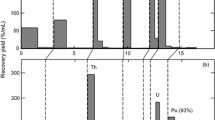Summary
Basic considerations for analyte enrichment and recovery obtainable by electrodialysis as a sample treatment method are given. Equations are derived which describe the dependence of the concentration profiles of ionic compounds on the electric field strength in a set-up with stagnant donor and acceptor solutions. It is shown that analyte recovery increases when less ion-selective membranes are used in the electrodialysis cell. Computer models are used to estimate the analyte enrichment for a flowing donor (sample) and a stagnant acceptor phase. About 10-fold enrichment can be obtained in an electrodialytic sample treatment system within 20 min under maximum current conditions. A compromise has to be found between analyte recovery and the donor (sample) flow rate.
Similar content being viewed by others
References
A. Kollrep and A. Wohl, Ger. Pat 136, 670 (1901).
P. H. Prausnitz andJ. Reitstötter, Elektrophoresis, Elektrosmose, Elektrodialyse, Steinkopff, Dresden and Leipzig, 1931.
N. Tsunakawa, Chem. Pharm. Bull.19, 1164 (1971).
N. Tsunakawa, Chem. Pharm. Bull.19, 2579 (1971).
N. Tsunakawa, Chem. Pharm. Bull.19, 2585 (1971).
J. A. Cox, R. Carlson, Anal. Chim. Acta130, 313 (1981).
M. W. F. Nielen, R. W. Frei, U. A. Th. Brinkman, in R. W. Frei and K. Zech (Eds.), “Selective Sample Handling and Detection in High-Performance Liquid Chromatography”, Part A, (J. Chromatogr. Library, Vol. 39A), Elsevier, Amsterdam, 1987, p. 5–80.
W. Th. Kok, Chromatographia24, 442 (1987).
W. Th. Kok, K.-P. Hupe, R. W. Frei, J. Chromatogr.436, 421 (1988).
A. J. J. Debets, R. W. Frei, K.-P. Hupe, W. Th. Kok, J. Chromatogr.465, 315 (1989).
A. J. J. Debets, K.-P. Hupe, U. A. Th. Brinkman, W. Th. Kok, Chromatographia29, 217 (1990).
D. C. Turnell, J. D. H. Cooper, J. Chromatogr.395, 613 (1987).
D. C. Turnell, J. D. H. Cooper, B. Green, F. Verillon, J. Chromatogr.456, 53 (1987).
U. R. Tjaden, E. A. Bruijn, R. A. M. van der Hoeven, C. Jol, J. van der Greef, H. Lingeman, J. Chromatogr.420, 53 (1987).
M. M. L. Aerts, W. M. J. Beek, U. A. Th. Brinkman, J. Chromatogr.435, 97 (1988).
M. M. L. Aerts, W. M. J. Beek, U. A. Th. Brinkman, J. Chromatogr.500, 453 (1990).
N. C. van de Merbel, J. M. Teule, H. Lingeman, U. A. Th. Brinkman, J. Pharm. Biomed. Anal.10, 225 (1992).
P. R. Haddad, S. Laksana, R. G. Simons, J. Chromatogr.640, 135 (1993).
A. J. J. Debets, W. Th. Kok, K.-P. Hupe, U. A. Th. Brinkman, Chromatographia30, 361 (1990).
A. J. J. Debets, K.-P. Hupe, W. Th. Kok, U. A. Th. Brinkman, J. Chromatogr.600, 163, (1992).
R. Aris, Proc. Roy. Soc. London, Ser. A235, 67 (1956).
W. Th. Kok, U. A. Th. Brinkman, R. W. Frei, Anal. Chim. Acta162, 19 (1984).
Author information
Authors and Affiliations
Rights and permissions
About this article
Cite this article
Debets, A.J.J., v. Wier, P., Hupe, K.P. et al. Theoretical models for electrodialytic sample treatment in trace analysis by liquid chromatography. Chromatographia 39, 460–468 (1994). https://doi.org/10.1007/BF02278763
Received:
Revised:
Accepted:
Issue Date:
DOI: https://doi.org/10.1007/BF02278763




